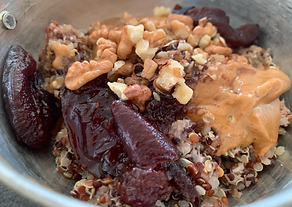
Marta De Wulf
Nutritionist and Natural Health Practitioner
Eating VS Nourishing
There is a difference between eating and nourishing. You can eat without nourishing your body - you can eat while still starving your body of essential nutrients. I’d like you to think about where your body is getting nutrients.
Take for instance a cup of cooked white rice VS a cup of chunky minestrone soup, both have the about the same amount of calories. The person who eats the white rice will get hungry before the person who eats the minestrone soup because the body is looking for nutrients, not just calories.
It’s asking where’s my calcium? my iron? my phosphorus?, etc… Your body needs nutrients to heal and thrive.
This is a Nutrient Dense, "Power Breakfast" that I created.
It tastes much better than it looks!

Irritable bowel syndrome and Celiac
Irritable Bowel Syndrome (IBS) is a common condition affecting the large intestine, often causing abdominal pain, bloating, and diarrhea. While not life-threatening, it can be disruptive—interfering with daily life, training, and social events.
Unlike celiac disease, which is an immune response to gluten, IBS is not triggered by an allergen but can still cause significant discomfort.
Managing IBS often involves dietary changes like the low FODMAP diet, navigating this on your own is overwhelming.
One reason is that certain carbohydrates aren’t fully broken down in the small intestine.
While enzymes like pancreatic amylase digest glucose-based carbs, others—like galacto-oligosaccharides and fructans—require different enzymes and can trigger IBS symptoms if not properly processed.

Avoiding Overeating: Practical Strategies for Lasting Change
A sign in the sauna read, “Avoid Overheating.” As a nutritionist, I couldn’t help but read it as “Avoid Overeating.”
Overeating isn’t just about what we eat, but how, when, and even why we eat. Here are simple, effective guidelines to help reduce the risk of overeating:
-
Use smaller plates – An 8-inch plate naturally encourages smaller portions.
-
Chew slowly – Eating mindfully helps you recognize fullness.
-
Put your fork down between bites – Slows the pace of your meal.
-
Keep extras in the kitchen – Out of sight, out of mind.
-
Serve from the kitchen – You’re less likely to go back for seconds.
-
Eat only when hungry – Distract yourself from emotional or boredom eating.
-
Avoid eating from packages – Portion out one serving at a time.
-
Sit down to eat – Avoid eating on the go, which leads to mindless snacking.
-
Check in with yourself – Are you actually hungry, or just tired or bored?
-
Drink water before meals – Helps curb appetite and supports hydration.
-
Choose high-fiber foods – They keep you full longer.
-
Eat a protein-rich breakfast – Reduces sugar cravings later in the day.
-
Don’t let yourself get overly hungry – It often leads to overeating.
Progress is gradual, but every small change moves you closer to your goals

Vitamin and Mineral Deficiencies
Most people even those with a ‘clean diet’ are deficient in many necessary vitamins and minerals.
I’ve analyzed many of my clients diets over the years - (I have them log for 4 days or longer if their diet varies greatly day-to-day). Even though most people’s diets appear to be balanced or clean, most are deficient in important vitamins and trace minerals.
The most common insufficient intakes are:
Vitamins: Folic acid (B9), vitamins B6 and B12, vitamin D
Minerals: Calcium, iron, magnesium and zinc (specifically vegetarians)*
It is note worthy that if your intake of these minerals is insufficient then your intake is others is also most likely low.
A raw mix, designed by me, specifically for their needs.

How Committed Are You to Your Health Goals?
On a scale of 1 to 10, how willing are you to make the changes needed to reach your goals?
Many clients confidently say "10"—they’re ready to move past the struggle and prioritize their goals over temptation. But not everyone starts there, and that’s okay.
A "9" often reflects doubt; an "8" allows room for indulgences; a "7" signals uncertainty, and a "6" may indicate hesitation or external pressure to make changes.
Interestingly, even some who say “10” find the work harder than expected. True transformation requires more than commitment—it takes conviction.
Commitment asks, “Can I do this?” Conviction answers, “I will.”
Over time, I see clients shift from doubt to confidence, from “I won’t have this today” to “I don’t need this today.” That mindset is where real change begins.

Smart Eating Strategies for Portion Control and Calorie Reduction
-
Start with low-calorie foods: Begin meals with salad and vegetables; eat meats and starches last to help reduce intake of higher-calorie items.
-
Stick to one serving: Avoid eating until full—stop after one portion and wait 15 minutes before considering seconds.
-
Enjoy broth-based soups: They’re filling but lower in calories than cream-based options.
-
Portion your food: Avoid eating directly from packages—serve out a reasonable amount.
-
Dining out? Downsize: Choose appetizers as entrees, or eat half your meal and take the rest home.
-
Choose lighter desserts: Share dessert or opt for fruit.
-
Eat at home when possible: Use smaller plates, like salad plates, to naturally reduce portions.
-
Swap condiments: Use mustard instead of mayo, or choose a low-fat version.
-
Pack a healthy lunch: Try pita wraps with lean protein, salads, yogurt, and fruit.
-
Drink smarter: Switch to 1% milk, limit juice to 4 oz (or dilute it), and avoid sugary drinks.
-
Cut liquid calories: Reducing soda, energy drinks, and high-calorie coffee beverages can lead to significant weight loss.
-
Limit alcohol: Reserve for weekends and stick to two drinks max.

I create recipes that are delicious, healthy and nutritious - often replacing unhealthy versions. Eating should be enjoyable too!